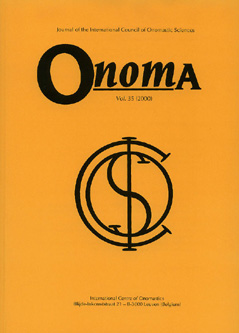 previous article in this issue previous article in this issue | next article in this issue  |

|
Document Details : Title: Nordic Hydronymy Author(s): STRANDBERG, Svante Journal: Onoma Volume: 37 Date: 2002 Pages: 145-164 DOI: 10.2143/ONO.37.0.519188 Abstract : The Nordic countries as a whole are very rich in hydronyms. The number of names associated with Swedish lakes may be much greater than 100,000. In Finland there are some 56,000 lakes with an area of at least one hectare (2.471 acres), in Danske sö- og anavne John Kousgard Sörensen deals with approximately 16.175 hike or river names. The ancient hydronyms of Denmark, Norway and Sweden have to a very large extent disappeared, but it is possible to reconstruct numerous lost hydronyms. There are many major contributions to Nordic hydronymic research. The largest work is Danske sö- eg anavne (1- 8. 1968 96). Nordic hydronyms have been dealt with in almost innumerable minor works over the hast hundred years. Among the hydronyms we find many of Scandinavian's very oldest place-names. The oldes1 stratum of Nordic hydronyms still preserved dates back to Proto-Indo-European times. The ancient names of the largest lakes and rivers in Denmark, Norway and Sweden are uncompounded. In the Proto-Germanic period uncompounded hydronyms still held a very strong position in Scandinavia. In an attempt to stratify ancient hydronyms chronologically on formal grounds (suffixes), it is necessary to distinguish between primary name formation (when new words arise) and secondary name formation (when already existing words begin to be used as names). Subjects of debate in the Nordic hydronymic research of today are for example chronology, suffixes, metonymy, analogy, ellipsis, epexegesis, dehydronymic derivation and Scandinavia and the alteuropäische Hydronymie. |
|
